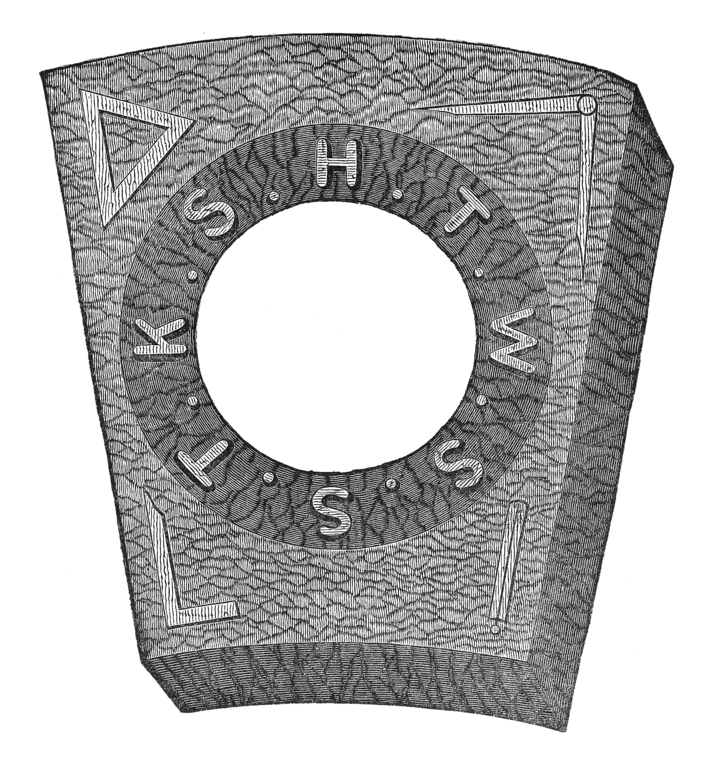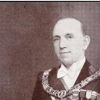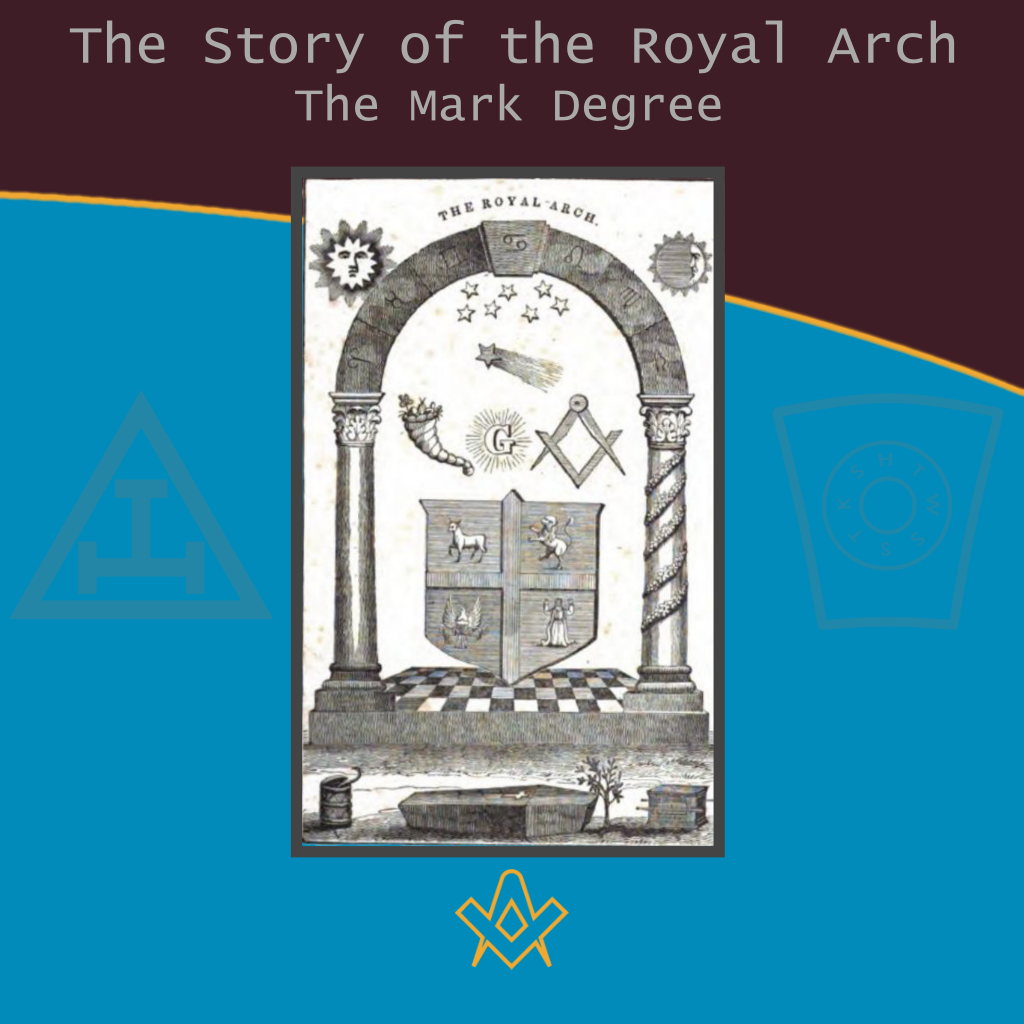The one link that connects the Mark Degree with that of the Royal Arch is the Keystone.
The whole of the Degree is built upon the cutting, the rejection, and the recovery of this particular piece of masonry at the time of the building of King Solomon’s Temple.
The Keystone was intended for the arch of the Sacred Vault , and almost five hundred years later when the Captives returned from Babylon to Jerusalem, the Sacred Vault yielded up its treasures for the good of humanity.
It is therefore at the Sacred Vault that the two Degrees find their common meeting point, and it may be that that is the reason why the logical Scot insists on regarding the Mark as pertaining to the ceremonial of the Royal Arch.

Keystone – the General Grand Chapter, Royal Arch Masons International – General Grand Chapter, Royal Arch Masons International, Public Domain
IMAGE LINKED: wikimedia Attribution 4.0 International (CC BY 4.0)
Officers of a Mark Lodge
The following are the recognised officers in a Lodge of Mark Masters: —
Mark Master.
Mark Senior Warden.
Mark Junior Warden.
Master Overseer.
Senior Overseer.
Junior Overseer.
Inner Guard.
Janitor.
Applicants for Advancement
Those who would be admitted to the Mark Degree must have been regularly entered Apprentices, passed Fellow-Crafts, and raised to the High and Sublime Degree of Master Masons.
They must be able to demonstrate their rank as masons when called upon, and they must be ready to reaffirm their faith in God, and to take upon themselves a further obligation to maintain secrecy with regard to all grips, signs and tokens.
The Chisel
Having expressed his desire to be advanced to the Degree of Mark Master Mason, and having been admitted within the door of the Lodge, the Master Mason is received on the edge of the Chisel an instrument that morally demonstrates the advantages of discipline and education by which means alone he may become a fit member of regularly organised society.
The Benefit of Prayer
As in all the earlier Degrees the blessing of Heaven is invoked.
‘Almighty God, G. and G.O. of the U., we humbly beseech Thy blessing upon this assembly gathered together in Thy name.
Do Thou especially bless him who now kneels before Thee.
Grant that he may so regulate his daily life that when, at the close of his earthly labours, he comes before Thee, he may be found worthy to receive the mark of Thy approval, and become a perfect stone in that immortal Temple not made with hands, eternal in the Heavens.’
To Prove His Right
Fortified thus by prayer, the postulant is addressed by the Mark Master who explains to him that since the building of K S’s T and the institution of the Degree of Mark Master Mason as now practised, a regulation has been made among the Craft that no one shall be advanced to the rank he now desires unless previously raised to the sublime degree of Master Mason, and he thereupon requests the postulant to demonstrate to the brethren assembled that he has passed through the earlier degrees.
How to choose a Mark
Having satisfied the brethren that he is qualified to receive the Degree, the Mason is next taught how to select his Mark which, once selected and recorded in the Mark Book of the Lodge, cannot thereafter be changed.
He is also taught the manner in which to apply for his wages; and thereafter, kneeling at the altar, in the manner sanctioned by long usage, repeats the…Obligation.
The Badge of a Mark Mason
Having been obligated and instructed in the secrets of the Degree the brother is invested with the badge and distinguishing jewel of a Mark Master Mason to signify his advancement in the science.
The jewel is a model of the stone which the builders rejected, the Keystone of the Arch of the Sacred Vault of King Solomon’s Temple.
The badge not only points out the brother’s rank as a Mark Master Mason, but is meant to remind him that whether he may m……, w…… or i……, his words and actions are observed and recorded by T.G.O.O.T.U, to Whom he must give an account of his conduct through life, and Who will reward or punish according as the brother has observed or disregarded His divine command.
The Mark
As a rule the Mark worn by Freemasons all over the world as an indication of their rank in the fraternity assumes the form of a Mark Master’s Keystone. It is made generally of pebble, sometimes of mother-of-pearl, occasionally of gold or silver.
The Mark should, in addition to the cryptic letters and equilateral triangle, contain the device adopted by the wearer, which device is really the person’s own mark chosen by himself, recorded in the mark book of his Lodge and not thereafter capable of being changed for any other device.
That model Keystone is a peculiar pledge of brotherhood and should a Mason in distress present such a badge to another Mason it is the duty of the latter to render such assistance as is within his power.

Stonemason’s mark from the early gothic period, exterior of the octagonal chancel, Trondheim Cathedral
IMAGE LINKED: wikimedia Attribution 4.0 International (CC BY 4.0)
Masons’ Marks
The subject of Masons’ Marks has given rise to much controversy.
Devices are to be found in all old buildings, often in great abundance.
It is not clear what their original purpose was, but there is a belief that they formed a sort of language understood by early operatives and were thus a means of communication.
Mr George Godwin, the eminent architect, though a non-mason, took great interest in the subject, and was one of the first to point out that marks were to be found on all important buildings of ecclesiastical or national importance.
He contributed a paper to the Transactions of the London Society of Antiquaries, and there he states that, in his opinion, ‘these marks, if collected, and compared, might assist in connecting the various bands of operatives, who, under the protection of the church — mystically united — spread themselves over Europe during the Middle Ages, and are known as Freemasons’.

Architecture: an assortment of masons tools, blocks of stone, and a folding rule. Engraving by Benard [after Lucotte?].
IMAGE LINKED: wellcome collection Attribution 4.0 International (CC BY 4.0)

Architecture: mason’s tools, masonry details. Engraving by Bénard after Lucotte.
IMAGE LINKED: wellcome collection Attribution 4.0 International (CC BY 4.0)
The Working Tools
The working tools of a Mark Master Mason are the Mallet and the Chisel. Every brother in passing through the E A and F C Degrees has been made familiar with their uses.
They are further employed by the Mark Master Mason to cut his mark of approval and thus to indicate that the finished stone is fitted for its place in the intended structure.
But by the brother who is not an operative but a member of the Free and Accepted or Speculative Masonic Body the tools are applied in a moral sense and thus become instruments of wise instruction.
The Chisel
The Chisel morally demonstrates the advantages of discipline.
The mind, like the diamond in its original state, is rude and unpolished; but as the effect of the chisel on the external coat soon brings to view the inner beauties of the gem, so education discovers the latent virtues of the mind, and draws them forth to range the wide field of matter and space, and to display the summit of human knowledge — our duty to God and man.
The Mallet
The Mallet morally teaches the thoughtful Freemason to correct irregularities, and reduce man to a proper level, so that by quiet deportment in the school of discipline, he may learn to be content.
What the Mallet is to the workman, enlightened reason is to the passions; it curbs ambition, represses envy, moderates anger, and encourages good dispositions, whence arises among good Masons that comely order which nothing earthly gives nor can destroy.
The soul’s calm sunshine, and the heart-felt joy.
By being reminded of the moral advantages of discipline and education the Freemason is, or should be, led to entertain a firm but humble hope that, by the correction of irregularities and the subjugation of passions, he may be found worthy to receive the approving mark of T.G.O.O.T.U., as fitted to form part of that spiritual edifice, ‘that house not made with hands, eternal in the heavens’.

Stone masons working on blocks of stone, making gravestones and coffins. Woodcut.
IMAGE LINKED: wellcome collection Attribution 4.0 International (CC BY 4.0)
Extracted from:
THE STORY OF THE ROYAL ARCH
By WILLIAM HARVEY, J. P.
Dundee : T.M. Sparks, 1919
[Pages 22-30]
Article by: William Harvey

William Harvey , J.P.,F.S.A (Scot) was initiated into Stirling Royal Arch No.76. He was a founding member of Lodge Progress No. 967, Dundee, and was R.W.M of that lodge from 1914 to 1916.
Harvey was installed as Provincial Grand Master of Forfarshire on the 23rd January 1935. Born in Stirling in 1874
He was trained as a law clerk but moved from law to journalism and joined John Leng & Co, Ltd, Dundee.
He was appointed general editor of the firms extensive series of novels. In 1904 he joined the staff of the 'Peoples Journal' and became assistant editor.
From 1908 to 1912 he was literary editor of the 'Dundee Advertiser'. He was a prolific writer of Masonic articles and books - his 'Harvey Manual of Degrees' is frequently used within the Lodges of Forfarshire.
He also published a number of small booklets on various Masonic topics. He was at Glamis when H.R.H. The Duke of York (the future King George VI) became an affiliate member of the Lodge of Glamis No. 99
Recent Articles: symbolism
 Legends and Symbols in Masonic Instruction Explore the significance of Masonic legends and symbols in this insightful post. Discover how Freemasonry imparts wisdom through allegorical narratives and emblematic imagery, revealing profound moral and philosophical lessons. Unveil the deep connections between Masonic teachings and the broader quest for understanding life’s fundamental questions. |
 Discover the mystical significance of the number 33. From its mathematical marvels and artistic influence in numerology to its esteemed place in Freemasonry, delve into the history and power of this master number. Explore why 33 holds such profound meaning in various spiritual and philosophical traditions. |
 The Practice of Freemasonry - P1 Embark on a transformative journey with Freemasonry, where the exploration of your Center unlocks the Perfect Ashlar within. Through the practices of Brotherly Love, Relief, Truth, and Cardinal Virtues, discover a path of enlightenment and self-improvement. Embrace the universal creed that binds us in the pursuit of our true essence. |
 Discover the fascinating history and significance of the Warrant of Constitution within Freemasonry. Unveil the evolution of this crucial authorization, its role in legitimizing Lodges, and its lasting impact on the global brotherhood of Freemasons. Explore the intricate link it provides between tradition and modern practice. |
 Freemasonry: Unravelling the Complexity of an Influential Organization Mysterious and captivating, Freemasonry has piqued the interest of seekers and skeptics alike. With its intricate blend of politics, esotericism, science, and religion, this enigmatic organization has left an indelible mark on society. Prepare to delve into the secrets of Freemasonry and unlock its hidden depths. |
 Unlocking the Mysteries of Freemasonry: In the hallowed halls of Freemasonry, a powerful symbol lies at the heart of ancient rituals and teachings—the Volume of the Sacred Law. This sacred book not only guides the spiritual and moral journey of Freemasons but also serves as a beacon of universal wisdom and enlightenment. |
 The Ancient Liberal Arts in Freemasonry Embark on a journey of self-improvement and wisdom with Freemasonry's guiding principles. Ascend the winding stairs of moral cultivation, analytical reasoning, and philosophical understanding. Embrace arithmetic's mystical properties and geometry's universal truths. Let the harmony of the universe inspire unity and growth. Discover the profound, hidden knowledge in Freemasonry's path to enlightenment. |
 Initiation rituals around the world are filled with fascinating elements and different images. One of them is that of darkness. When societies speak of darkness, they often mean a lack of knowledge, a lack of choice, or a symbol of evil. During initiation rituals, darkness is used to represent the initiate's lack of knowledge about the world, society, and initiation in general. It can also represent the initiate's inability to make a choice or endure a situation. Whether you have participated in an initiation rite or not, the meaning of darkness remains an intriguing concept worth exploring. Initiation rituals around the world are filled with fascinating elements and different images. One of them is that of darkness. When societies speak of darkness, they often mean a lack of knowledge, a lack of choice, or a symbol of evil. During initiation rituals, darkness is used to represent the initiate's lack of knowledge about the world, society, and initiation in general. It can also represent the initiate's inability to make a choice or endure a situation. Whether you have participated in an initiation rite or not, the meaning of darkness remains an intriguing concept worth exploring. |
 Masonic Deacon rods potentially trace their origins to Greek antiquity, symbolically linked to Hermes' caduceus. As Hermes bridged gods and mortals with messages, so do Masonic Deacons within the lodge, reinforcing their roles through ancient emblems. This connection underscores a profound narrative, weaving the fabric of Masonic rites with the threads of mythological heritage, suggesting the rods are not mere tools but bearers of deeper, sacred meanings that resonate with the guardianship and communicative essence of their divine counterpart, Hermes, reflecting a timeless lineage from myth to Masonic tradition. |
 The biblical pillars erected by Solomon at the Temple's porch, hold a profound place in history. These brass behemoths are not mere decorations; they are symbols of strength, establishment, and divine guidance. Explore their fascinating construction, dimensions, and the deep meanings they carry in both biblical and Masonic contexts. |
 Unlocking the Mind's Potential: Dive deep into ground breaking research revealing how simple daily habits can supercharge cognitive abilities. Discover the untapped power within and redefine your limits. Join us on this enlightening journey and transform your world! |
 Dive deep into the symbolic importance of the trowel in Masonry, representing unity and brotherly love. From its historical roots in operative masonry to its significance in speculative masonry, this article explores the trowel's multifaceted role. Discover its connection to the sword, the story of Nehemiah, and the Society of the Trowel in Renaissance Florence. Unravel the layers of meaning behind this enduring Masonic symbol. |
 Symbolism of The Builder's Jewel Batty Langley's "The Builder’s Jewel" (1741) is a visual masterpiece of Masonic symbolism, showcasing Langley's deep understanding of Freemasonry. The frontispiece highlights key symbols like the three pillars and the legend of Hiram Abiff, emphasizing Langley's dedication to Masonic traditions and teachings. |
 Unveil the mystique of the colour blue in Masonic symbolism. A hue evoking universal friendship and benevolence, its roots span ancient cultures, infusing Freemasonry's core values. This article explores blue's profound significance, guiding Freemasons towards wisdom and spiritual enlightenment. Discover the fascinating journey of this universal symbol. |
 Discover the intriguing world of the plumb in Masonic symbolism with our in-depth analysis. Uncover its rich history, moral teachings, and significance in Freemasonry, guiding members on their path to truth, integrity, and justice. Immerse yourself in the captivating power of this symbol that shapes lives within the brotherhood. |
 Unlock the mysteries of Freemasonry with 'The Key,' a profound Masonic symbol. This seemingly simple instrument holds a deeper meaning, teaching virtues of silence and integrity. Explore its ancient roots, from Sophocles to the mysteries of Isis, and discover how it symbolizes the opening of the heart for judgment. |
 Unlock the secrets of the Freemasonry with The Blazing Star - a symbol that holds immense significance in their rituals and practices. Delve into its history, meaning and role in the different degrees of Freemasonry with expert insights from the Encyclopedia of Freemasonry by Albert Mackey. Discover the mystique of The Blazing Star today! |
 There is no symbol more significant in its meaning, more versatile in its application, or more pervasive throughout the entire Freemasonry system than the triangle. Therefore, an examination of it cannot fail to be interesting to a Masonic student. Extract from Encyclopedia of Freemasonry by Albert Mackey |
 The Hiramic Legend and the Myth of Osiris Hiram Abiff, the chief architect of Solomon’s Temple, is a figure of great importance to Craft Freemasonry, as its legend serves as the foundation of the Third Degree or that of a Master Mason. He is the central figure of an allegory that has the role of teaching the Initiate valuable alchemical lessons. Although his legend is anchored in biblical times, it may have much older roots. |
 This rite of investiture, or the placing upon the aspirant some garment, as an indication of his appropriate preparation for the ceremonies in which he was about to engage, prevailed in all the ancient initiations. Extract from The Symbolism of Freemasonry by Albert G. Mackey |
 The All-Seeing Eye of God, also known as the Eye of Providence, is a representation of the divine providence in which the eye of God watches over humanity. It frequently portrays an eye that is enclosed in a triangle and surrounded by rays of light or splendour. |
 What's in a Word, Sign or Token? Why do Freemasons use passwords, signs, and tokens? As Freemasons we know and understand the passwords, signs and tokens (including grips), which are all used a mode of recognition between members of the fraternity. |
 A Temple of Living Stones: Examining the Concept of a Chain of Union What are the origins of the Chain of Union? And how did they come about ? The answers may surprise some members as W Brother Andrew Hammer investigates, author of Observing the Craft: The Pursuit of Excellence in Masonic Labour and Observance. |
 One of the best loved stories for the festive season is ‘A Christmas Carol’. A traditional ghost story for retelling around the fire on a cold Christmas Eve, it is a timeless classic beloved by those from all walks of life. Philippa explores the masonic allegory connections… |
 The Trowel - Working Tool of the Master Mason The Trowel is the symbol of that which has power to bind men together – the cement is brotherhood and fellowship. |
 Two Perpendicular Parallel Lines The point within a circle embordered by two perpendicular parallel lines, with the Holy Bible resting on the circle, is one of the most recognizable symbols in Freemasonry. It is also one which always raises a question. How can two lines be both perpendicular and parallel? |
 "The first great duty, not only of every lodge, but of every Mason, is to see that the landmarks of the Order shall never be impaired." — Albert Mackey (1856) |
 It is common knowledge that the ancient wages of a Fellowcraft Mason consisted of corn, wine, and oil. |
 “Do not come any closer,” God said. “Take off your sandals, for the place where you are standing is holy ground.” Exodus 3:5 |
 The Secret Language of the Stone Masons We know of Masons' Marks but lesser known are the 'argots' used by the artisans - in part 2 of a series on the social history of the Operative Masons we learn how the use of secret languages added to the mystery of the Guilds. |
 The phrase appears in the Regius Poem. It is customary in contemporary English to end prayers with a hearty “Amen,” a word meaning “So be it.” It is a Latin word derived from the Hebrew word - Short Talk Bulletin - Vol. V June, 1927, No.6 |
 Egypt's 'Place of Truth' - The First Operative Stone Masons' Guild? Was ancient Egypt's 'village of the artisans' the first operative stone masons' guild? And was their use of 'identity marks' a forerunner of the Mason's Marks of the cathedral builders of the Middle Ages? Read on for some possible answers… |
 The Pieces of Architecture and the Origin of Masonic Study Discover the journey of the Apprentice – from Operative to Speculative. This journey has been carried out since the times of operative Freemasonry but today the initiate works in the construction of his inner temple. |
 The Builders' Rites - laying the foundations operatively and speculatively The cornerstone (also ‘foundation’ or ‘setting’ stone) is the first stone to be set in the construction of the foundations of a building; every other stone is set in reference to this. |
 Applying the working tools to achieve our peculiar system of morality. |
 We take an in-depth look at the 47th Proposition of the 1st Book of Euclid as part of the jewel of the Past Master. |
 The Cable Tow: Its Origins, Symbolism, & Significance for Freemasons - Unbinding the significance of the cable tow. |
 We examine at one of the most impressive moments of the initiatory ceremony, a certain rite known as Circumambulation, and ask what is its meaning and purpose ? |
 So, what is the Level? And why do we use it in Freemasonry? |
 What is the mysterious pigpen or Masonic cipher that has been used for centuries to hide secrets and rituals? |
 The Story of the Royal Arch - The Mark Degree Extracted from William Harvey's 'The Story of the Royal Arch' - Part 1 describes the Mark Degree, including the Working Tools. |
 Ashlars - Rough, Smooth - Story of a Stone How we can apply the rough and smooth Ashlars with-in a masonic context |
 A detailed look at the Chamber of Reflection: A Revitalized and Misunderstood Masonic Practice. |
 Exploring the origin and symbolism of Faith, Hope and Charity |
 The Noachite Legend and the Craft What is it to be a true Noachidae, and what is the Noachite Legend and the Craft ? |
 In Masonic rituals, Jacob’s ladder is understood as a stairway, a passage from this world to the Heavens. |
 What is the meaning of the Acacia and where did it originate ? |
 What is the connection with the Feasts of St John and Freemasonry |
 The Forget-Me-Not and the Poppy - two symbols to remind us to 'never forget' those who died during the two World Wars. |
 Biblical history surrounding the two pillars that stood at the entrance to King Solomon's Temple |
 Is there a direct link between Judaism and Freemasonry? |
 The symbolism of the beehive in Masonry and its association with omphalos stones and the sacred feminine. |
 The Wages of an Entered Apprentice |
 An explanation of the North East corner charge which explores beyond one meaning Charity - |
 A brief look at the origins of the two headed eagle, probably the most ornamental and most ostentatious feature of the Supreme Council 33rd Degree Ancient and Accepted (Scottish ) Rite |
 A Muslim is reminded of his universal duties just as a Freemason. A Masonic Interpretation of the Quran's First Two Chapters |
 The three Latin words -{Listen, Observe, Be Silent}. A good moto for the wise freemason |
masonic knowledge
to be a better citizen of the world
share the square with two brothers

click image to open email app on mobile device







